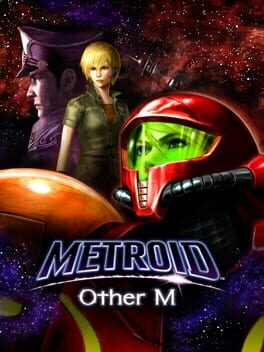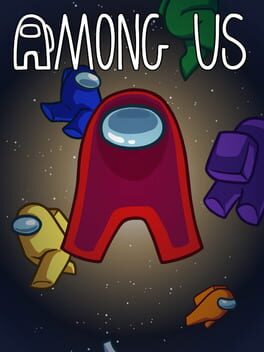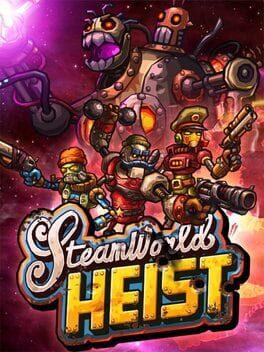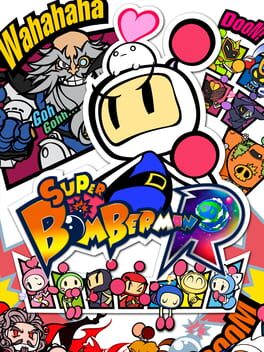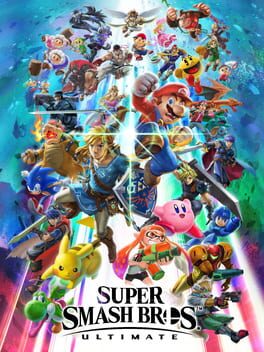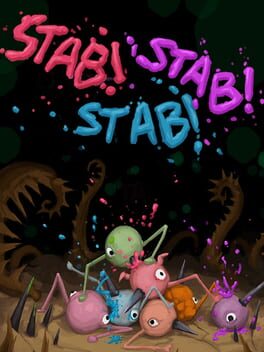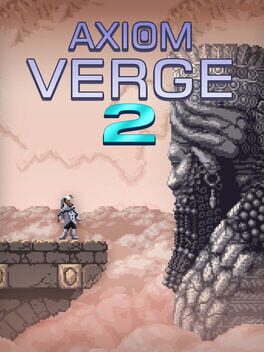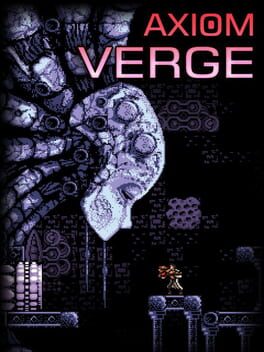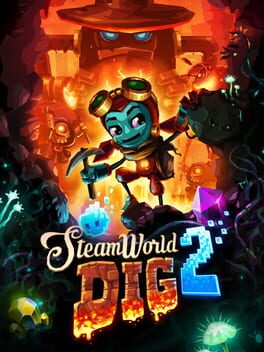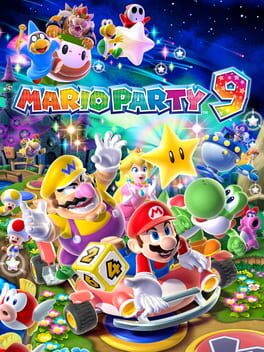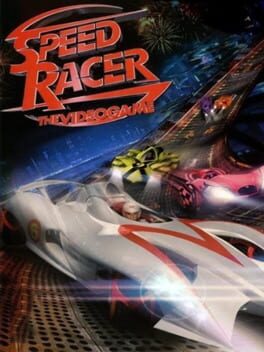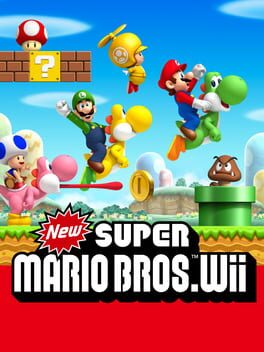Francca
2010
Pros:
+ Some of the best visual fidelity out of any Wii game
+ Concept is interesting, following Samus directly after Super Metroid but before Fusion. I think there is a story to be told there. Same with the 3D platformer perspective as opposed to the Prime games' FPA approach.
+ Combat is idiotically simplistic, but admittedly still kind of fun
+ The origin/evolutionary line the game gives for Ridley's species is absolutely excellent. I love the idea that the huge, spiky space pirate we know and love from the other games was originally a tiny, white-colored and furry Little Birdie. This minor factoid is literally the single best thing about this entire godforsaken game, and that's saying something.
Cons:
- Level and world design is repulsively bad. I'm no stranger to linear hallways in 3D Metroid games, Prime 3's my favorite Prime game after all, but the way Other M does it is especially horrid. Environments are rarely - if ever - interesting-looking, with seemingly all depth and detail having been sucked out of them. Each area in the game is basically just a circular road (with little to no crossroads) you shoot through rather than an interconnected world. It doesn't even make sense in the context of being inside a Federation research vessel. Why are all of the doors decorative instead of actual shortcuts? At least Fusion's linear areas still had interesting theming, and Prime 3 especially so. Prime 3's linearity was also alleviated with the fact that you could call your gunship to different parts of the world and cut on the backtracking. Other M's seemingly infinitely generating hallways are so bland, that you couldn't describe or discern any different traits about them without looking at the map.
- I'll mention the core upgrades later as part of the story breakdown, but the rest of the item progression is also very bad for seemingly non-story-related reasons. The specific location of Energy Tanks and Missile Upgrades are directly shown on the map so the linear hallways don't even have the benefit of fleshing them out by housing secret upgrades in interesting spots. There is almost zero reason to backtrack, ever. It's effectively not even really a metroidvania other than by name.
- For some reason, the game's director decided it would be a good idea to design the game to be played with a single horizontal Wii Remote. The outcome is as you'd expect: a game focused on fast-paced combat and precise three-dimensional movement makes you use a tiny D-Pad and three other main buttons on the controller. Yoshio Sakamoto claimed this would improve the developers' creativity in designing around the controller's limitations, but what it actually did is force the developers to make the rooms so narrow and dimensionally straightforward that you basically just keep running forwards and occasionally turning left or right. Perhaps the most hilarious part of the controls, however, is the fact that to increase your missile ammo you have to lift up your Wiimote, and to precisely aim those missiles you have to start aiming the usually horizontal Wiimote at your screen. Absolutely bafflng.
- While the combat feels fun, it's also moronically easy. You can just spam dodge moves that automatically charge your beam to full, so you're never in a bad situation except when against specific bosses with huge attacks or multiple unreachable enemies shooting projectiles.
- I mentioned earlier that the game's graphical fidelity is high. I chose those specific words, because its actual designs are dog water. The lighting and polygon count looks impressive, sure, but there is no inspiration or detail in any of the characters, environments or backgrounds. Samus' suit is one of - if not the worst - in the entire franchise, with its smooth edges, minimalistic depths and lack of any striking elements (aside from its color) making it look like a generic mecha suit from a B-tier anime from the early oughts.
- Following the uninteresting visual designs, Other M's music is also either forgettable at best or offensively bad at worst. It's so bad that Smash Ultimate didn't even bring any of its music over from Smash 4, where it was used for the Pyrosphere stage inspired by Other M.
- Other M is extremely derivative (light-to-medium spoilers incoming). It's full of fanservice, got barely any ideas of its own and even when it does, they are executed horribly. The game has a fake Ridley that fails to explain Neo Ridley's existence in Fusion (because lore accuracy was never the point, the developers just thought that they need a Ridley in the game). It has a Queen Metroid, a "Mother Brain" and even a Phantoon, just because they're bosses that people would recognize from previous Metroid games. The game even has a sequence referencing the Zero Suit Samus section from Zero Mission's ending, because the developers didn't know how to properly finish up the story. The entire game incoherently mashes up uninspired retreads of previous elements like this, trying to fill up the holes left open by its embarrassingly unengaging narrative and gameplay.
- Next are some story spoilers, which you don't have to read through, but rest assured, you would not have fun with the core gameplay of this game even if you completely ignored the horrible narrative tying it all together.
(FULL STORY SPOILERS are next, please don't scroll lower if you want to experience it for yourself, for some reason. I don't usually do this for games I review as I like to keep them spoiler-free, but so much of why Other M doesn't work is directly tied to its lore that I can't not talk about it.)
Cons regarding story:
- As mentioned above, Other M fails to create a story that follows any logic or canon, even contradicting itself during the course of the game. I'm not a person who usually cares for a deep story, but Other M fails in its narrative so incredibly badly that it - for once - actively hurts the experience of the game, and even the entire Metroid franchise in general. It's so indescribably bad, that I needed to write this entire separate section of my review.
• Firstly and worstly, Samus' characterization. It's all over the place, and definitely not consistent to this or previous games. She is written to be way more submissive, dependent on outside (male) help and generally being nothing like the silent badass she appeared as in previous or later games. Even her suit reflects this deep misunderstanding of her character: it's sleeker, presents more feminine, and is stripped of any of the general and menacing androgynous efficiency that her previous iterations exhibited. The most egregious example of the butchering of Samus' character undoubtedly comes in the form of her having a PTSD trigger attack when she sees Ridley again at roughly the midpoint of the game. This makes zero sense, and proves the developers did not care to follow any logical consistency.
Even if you only account for the 2D Metroids that occur prior to this game's story, she has met and defeated Ridley three times already. If you also want to include the more canonical Metroid Manga as well as the Prime saga that had released at the time (as you should), she's fought Ridley at least 7 times. And seen him without fighting him even more often. It makes less than zero sense that she is having a PTSD attack right now, in Other M.
• Adam isn't how he is in Fusion, either. Fusion's AI Adam is cold-hearted, calculative and logical, sure, but it's implied that's just because he's a computer. He softens at the end of that game and Samus also describes him as a caring commander when she still worked for him directly. But not in Other M.
The Adam players see in Other M is not the same person. He's rude, commanding, unimpressive as a role model and even genuinely stupid. He exhibits none of the traits Samus gushed over in Fusion. I wouldn't even have a problem with Samus idolizing Adam in this game if he actually reflected the description that Samus gave of him, but he's just not a likeable character. Not even in a flawed, Tony Stark-like way.
• The biggest issue about Adam also relates to one of the biggest issues with the entire game: the upgrade authorization system. With respect to the developers, they actually tried to explain why Samus loses all of his upgrades at the beginning of every game. Too bad their explanation is horrible, and the lore is genuinely better off without it. Samus apparently has all of her upgrades already downloaded onto her suit or something, but she chooses not to use them. When we meet her at the beginning of the game, she's using her Power Suit for some reason. This makes zero sense if she was just flying around alone, then being summoned to the Federation's ship. When Samus meets Adam, she's ordered not to use her upgrades, for... vague, incomprehensible non-reasons. Adam says he'll only "authorize" certain upgrades if Samus seems to need them and he feels like being nice. My three favorite, worst examples of this authorization system in action go as follows:
1: Samus is in Pyrosphere, an area of the huge ship with a dangerously hot climate. She's been in the insulated areas for now, so it hasn't been a problem, but she could've already received her Varia Suit earlier to protect her from possible heat attacks, but isn't given it earlier for whatever reason. The point where she's "authorized" to use a life-saving suit modification is when a monster destroys the tube she's running through and she's already in a molten environment. Adam sees Samus' health already getting drained by the elements and at that point chooses to allow Samus use the Varia Suit.
2: In another part, in Cryosphere, Samus is trapped in a glass box by her enemies. These enemies can shoot her through the box's walls, but Samus can't shoot back to disable the trap. Only after multiple seconds of evading attacks does Samus finally get authorization to use the Wave Beam so she can shoot the enemies through walls. Amazing.
3: Finally, close to the end of the game, Samus is about to fly out of a vacuum hatch in the ship, literally being meters away from getting sucked out into outer space. Adam is unresponsive in her pleas to authorize the Gravity Suit, so she activates the suit upgrade herself. Samus has had the ability to authorize the upgrades herself all this time, but chose to threaten her own life to enable Adam's weird and idiotic power fantasy.
• The main villain of the game is Mother Brain, or Melissa Bergman, or "MB". She's the titular "Other M" in the title, as in another M, another Mother Brain. I know, very clever. Apparently the Galactic Federation preserved a version of the original Mother Brain as a human scientist, who then went rogue on the Bottle Ship and employed all of the different enemies to attack the Federation so MB could take escape and take control of the Metroids once again. To accomplish this, she changed her name to Melissa Bergman (maintaining her initials for whatever reason) and blended in with the scientists so she could enact her plan. Unfortunately for her, she was caught. Now, if this plan and character sounds idiotic to you, rest assured, it is.
• All of the supporting side characters are also mostly very bland and uninteresting. The game has no real deep themes to be had, despite seeing itself as a serious piece of media. For whatever reason, the developers actually thought this material was good enough to warrant a "Movie Mode" in the game, which just plays all of the game's cutscenes in order.
• Most of the dialogue is simplistic, thesaurus-filled fluff. The director doesn't know how to write believable characters, so half the time Samus is just monologuing about how the baby Metroid saved her at the end of Super Metroid.
TL;DR, don't play this game. Trust others when they tell you it's bad. Sometimes your psychological wellbeing has to go above the principle of playing a game before criticizing it.
+ Some of the best visual fidelity out of any Wii game
+ Concept is interesting, following Samus directly after Super Metroid but before Fusion. I think there is a story to be told there. Same with the 3D platformer perspective as opposed to the Prime games' FPA approach.
+ Combat is idiotically simplistic, but admittedly still kind of fun
+ The origin/evolutionary line the game gives for Ridley's species is absolutely excellent. I love the idea that the huge, spiky space pirate we know and love from the other games was originally a tiny, white-colored and furry Little Birdie. This minor factoid is literally the single best thing about this entire godforsaken game, and that's saying something.
Cons:
- Level and world design is repulsively bad. I'm no stranger to linear hallways in 3D Metroid games, Prime 3's my favorite Prime game after all, but the way Other M does it is especially horrid. Environments are rarely - if ever - interesting-looking, with seemingly all depth and detail having been sucked out of them. Each area in the game is basically just a circular road (with little to no crossroads) you shoot through rather than an interconnected world. It doesn't even make sense in the context of being inside a Federation research vessel. Why are all of the doors decorative instead of actual shortcuts? At least Fusion's linear areas still had interesting theming, and Prime 3 especially so. Prime 3's linearity was also alleviated with the fact that you could call your gunship to different parts of the world and cut on the backtracking. Other M's seemingly infinitely generating hallways are so bland, that you couldn't describe or discern any different traits about them without looking at the map.
- I'll mention the core upgrades later as part of the story breakdown, but the rest of the item progression is also very bad for seemingly non-story-related reasons. The specific location of Energy Tanks and Missile Upgrades are directly shown on the map so the linear hallways don't even have the benefit of fleshing them out by housing secret upgrades in interesting spots. There is almost zero reason to backtrack, ever. It's effectively not even really a metroidvania other than by name.
- For some reason, the game's director decided it would be a good idea to design the game to be played with a single horizontal Wii Remote. The outcome is as you'd expect: a game focused on fast-paced combat and precise three-dimensional movement makes you use a tiny D-Pad and three other main buttons on the controller. Yoshio Sakamoto claimed this would improve the developers' creativity in designing around the controller's limitations, but what it actually did is force the developers to make the rooms so narrow and dimensionally straightforward that you basically just keep running forwards and occasionally turning left or right. Perhaps the most hilarious part of the controls, however, is the fact that to increase your missile ammo you have to lift up your Wiimote, and to precisely aim those missiles you have to start aiming the usually horizontal Wiimote at your screen. Absolutely bafflng.
- While the combat feels fun, it's also moronically easy. You can just spam dodge moves that automatically charge your beam to full, so you're never in a bad situation except when against specific bosses with huge attacks or multiple unreachable enemies shooting projectiles.
- I mentioned earlier that the game's graphical fidelity is high. I chose those specific words, because its actual designs are dog water. The lighting and polygon count looks impressive, sure, but there is no inspiration or detail in any of the characters, environments or backgrounds. Samus' suit is one of - if not the worst - in the entire franchise, with its smooth edges, minimalistic depths and lack of any striking elements (aside from its color) making it look like a generic mecha suit from a B-tier anime from the early oughts.
- Following the uninteresting visual designs, Other M's music is also either forgettable at best or offensively bad at worst. It's so bad that Smash Ultimate didn't even bring any of its music over from Smash 4, where it was used for the Pyrosphere stage inspired by Other M.
- Other M is extremely derivative (light-to-medium spoilers incoming). It's full of fanservice, got barely any ideas of its own and even when it does, they are executed horribly. The game has a fake Ridley that fails to explain Neo Ridley's existence in Fusion (because lore accuracy was never the point, the developers just thought that they need a Ridley in the game). It has a Queen Metroid, a "Mother Brain" and even a Phantoon, just because they're bosses that people would recognize from previous Metroid games. The game even has a sequence referencing the Zero Suit Samus section from Zero Mission's ending, because the developers didn't know how to properly finish up the story. The entire game incoherently mashes up uninspired retreads of previous elements like this, trying to fill up the holes left open by its embarrassingly unengaging narrative and gameplay.
- Next are some story spoilers, which you don't have to read through, but rest assured, you would not have fun with the core gameplay of this game even if you completely ignored the horrible narrative tying it all together.
(FULL STORY SPOILERS are next, please don't scroll lower if you want to experience it for yourself, for some reason. I don't usually do this for games I review as I like to keep them spoiler-free, but so much of why Other M doesn't work is directly tied to its lore that I can't not talk about it.)
Cons regarding story:
- As mentioned above, Other M fails to create a story that follows any logic or canon, even contradicting itself during the course of the game. I'm not a person who usually cares for a deep story, but Other M fails in its narrative so incredibly badly that it - for once - actively hurts the experience of the game, and even the entire Metroid franchise in general. It's so indescribably bad, that I needed to write this entire separate section of my review.
• Firstly and worstly, Samus' characterization. It's all over the place, and definitely not consistent to this or previous games. She is written to be way more submissive, dependent on outside (male) help and generally being nothing like the silent badass she appeared as in previous or later games. Even her suit reflects this deep misunderstanding of her character: it's sleeker, presents more feminine, and is stripped of any of the general and menacing androgynous efficiency that her previous iterations exhibited. The most egregious example of the butchering of Samus' character undoubtedly comes in the form of her having a PTSD trigger attack when she sees Ridley again at roughly the midpoint of the game. This makes zero sense, and proves the developers did not care to follow any logical consistency.
Even if you only account for the 2D Metroids that occur prior to this game's story, she has met and defeated Ridley three times already. If you also want to include the more canonical Metroid Manga as well as the Prime saga that had released at the time (as you should), she's fought Ridley at least 7 times. And seen him without fighting him even more often. It makes less than zero sense that she is having a PTSD attack right now, in Other M.
• Adam isn't how he is in Fusion, either. Fusion's AI Adam is cold-hearted, calculative and logical, sure, but it's implied that's just because he's a computer. He softens at the end of that game and Samus also describes him as a caring commander when she still worked for him directly. But not in Other M.
The Adam players see in Other M is not the same person. He's rude, commanding, unimpressive as a role model and even genuinely stupid. He exhibits none of the traits Samus gushed over in Fusion. I wouldn't even have a problem with Samus idolizing Adam in this game if he actually reflected the description that Samus gave of him, but he's just not a likeable character. Not even in a flawed, Tony Stark-like way.
• The biggest issue about Adam also relates to one of the biggest issues with the entire game: the upgrade authorization system. With respect to the developers, they actually tried to explain why Samus loses all of his upgrades at the beginning of every game. Too bad their explanation is horrible, and the lore is genuinely better off without it. Samus apparently has all of her upgrades already downloaded onto her suit or something, but she chooses not to use them. When we meet her at the beginning of the game, she's using her Power Suit for some reason. This makes zero sense if she was just flying around alone, then being summoned to the Federation's ship. When Samus meets Adam, she's ordered not to use her upgrades, for... vague, incomprehensible non-reasons. Adam says he'll only "authorize" certain upgrades if Samus seems to need them and he feels like being nice. My three favorite, worst examples of this authorization system in action go as follows:
1: Samus is in Pyrosphere, an area of the huge ship with a dangerously hot climate. She's been in the insulated areas for now, so it hasn't been a problem, but she could've already received her Varia Suit earlier to protect her from possible heat attacks, but isn't given it earlier for whatever reason. The point where she's "authorized" to use a life-saving suit modification is when a monster destroys the tube she's running through and she's already in a molten environment. Adam sees Samus' health already getting drained by the elements and at that point chooses to allow Samus use the Varia Suit.
2: In another part, in Cryosphere, Samus is trapped in a glass box by her enemies. These enemies can shoot her through the box's walls, but Samus can't shoot back to disable the trap. Only after multiple seconds of evading attacks does Samus finally get authorization to use the Wave Beam so she can shoot the enemies through walls. Amazing.
3: Finally, close to the end of the game, Samus is about to fly out of a vacuum hatch in the ship, literally being meters away from getting sucked out into outer space. Adam is unresponsive in her pleas to authorize the Gravity Suit, so she activates the suit upgrade herself. Samus has had the ability to authorize the upgrades herself all this time, but chose to threaten her own life to enable Adam's weird and idiotic power fantasy.
• The main villain of the game is Mother Brain, or Melissa Bergman, or "MB". She's the titular "Other M" in the title, as in another M, another Mother Brain. I know, very clever. Apparently the Galactic Federation preserved a version of the original Mother Brain as a human scientist, who then went rogue on the Bottle Ship and employed all of the different enemies to attack the Federation so MB could take escape and take control of the Metroids once again. To accomplish this, she changed her name to Melissa Bergman (maintaining her initials for whatever reason) and blended in with the scientists so she could enact her plan. Unfortunately for her, she was caught. Now, if this plan and character sounds idiotic to you, rest assured, it is.
• All of the supporting side characters are also mostly very bland and uninteresting. The game has no real deep themes to be had, despite seeing itself as a serious piece of media. For whatever reason, the developers actually thought this material was good enough to warrant a "Movie Mode" in the game, which just plays all of the game's cutscenes in order.
• Most of the dialogue is simplistic, thesaurus-filled fluff. The director doesn't know how to write believable characters, so half the time Samus is just monologuing about how the baby Metroid saved her at the end of Super Metroid.
TL;DR, don't play this game. Trust others when they tell you it's bad. Sometimes your psychological wellbeing has to go above the principle of playing a game before criticizing it.
2018
Pros:
+ Nice little party game to play with friends
+ Lots of customizability and easily joinable public lobbies
+ Good sound design
+ A great team working on all the updates and adding meaningful and/or requested stuff in each one (take notes, Mojang)
+ One of the only videogames you can successfully play with more than 8 friends at a time
+ One-of-a-kind concept
+ The new item boxes are fun to 100%
+ The Switch version has some really good controls for the crewmate tasks
Cons:
- Just not that engaging after a while, doesn’t really speak to me that much anymore even though I recognize the novelty
- No side content aside from the main game, which is acceptable on the free mobile version but not so much on the others
- While it’s nice to have the option of customizability, it’s also a kind of barrier to entry to figure out the rules each time someone wants to change them when you’d really just want to play and get it over with
- Only really fun enough with real friends
+ Nice little party game to play with friends
+ Lots of customizability and easily joinable public lobbies
+ Good sound design
+ A great team working on all the updates and adding meaningful and/or requested stuff in each one (take notes, Mojang)
+ One of the only videogames you can successfully play with more than 8 friends at a time
+ One-of-a-kind concept
+ The new item boxes are fun to 100%
+ The Switch version has some really good controls for the crewmate tasks
Cons:
- Just not that engaging after a while, doesn’t really speak to me that much anymore even though I recognize the novelty
- No side content aside from the main game, which is acceptable on the free mobile version but not so much on the others
- While it’s nice to have the option of customizability, it’s also a kind of barrier to entry to figure out the rules each time someone wants to change them when you’d really just want to play and get it over with
- Only really fun enough with real friends
Pros:
+ Literally the only turn-based RTS I’ve ever been interested in trying, and it was worth it
+ Great gameplay, the movement and overall experience is way more fast-paced and filled with different unique options than you would expect from a turn-based game
+ Really fun characters and world
+ Lots of different weapons and cosmetic hats to collect
+ Simple fun while still being really challenging at times
+ One of the best OSTs in a game I’ve ever heard, having been composed by steampunk band Steam Powered Giraffe (and you can even find them in-game in the space bars!)
+ After playing SteamWorld Dig 2 a few years earlier, its events directly and faithfully lead to this game and I wasn’t disappointed
Cons:
- So short for its genre :( only around 20-25 hours even if you 100% the game
- New Game+ doesn’t change the game substantially enough
- While it’s great that most levels are procedurally generated, they could have more different themes. They’re effectively all just differently colored spaceships with some different hazards. Maybe there could be one where a station is built on an asteroid, for example?
+ Literally the only turn-based RTS I’ve ever been interested in trying, and it was worth it
+ Great gameplay, the movement and overall experience is way more fast-paced and filled with different unique options than you would expect from a turn-based game
+ Really fun characters and world
+ Lots of different weapons and cosmetic hats to collect
+ Simple fun while still being really challenging at times
+ One of the best OSTs in a game I’ve ever heard, having been composed by steampunk band Steam Powered Giraffe (and you can even find them in-game in the space bars!)
+ After playing SteamWorld Dig 2 a few years earlier, its events directly and faithfully lead to this game and I wasn’t disappointed
Cons:
- So short for its genre :( only around 20-25 hours even if you 100% the game
- New Game+ doesn’t change the game substantially enough
- While it’s great that most levels are procedurally generated, they could have more different themes. They’re effectively all just differently colored spaceships with some different hazards. Maybe there could be one where a station is built on an asteroid, for example?
2017
Pros:
+ Pretty fun with both pro and casual players alike, even years later
+ Surprisingly deep strategizing and gameplay
+ Great stages
+ Solid music
+ Decent story mode with some fun bosses (except the second-to-last one is absolute bull with its weak points and downtime duration)
+ Konami’s other Special-class characters add some interesting variety
+ Lots to unlock from stages to accessories for your characters
Cons:
- It was 50€ at launch 💀💀💀
- Not that fun alone
- Money takes forever to grind even with the fastest strategies. It should’ve been rewarded from matches depending on how long they last so you got more of it passively while playing with friends, for example
- Can get boring pretty quick if you don’t switch between other party games
+ Pretty fun with both pro and casual players alike, even years later
+ Surprisingly deep strategizing and gameplay
+ Great stages
+ Solid music
+ Decent story mode with some fun bosses (except the second-to-last one is absolute bull with its weak points and downtime duration)
+ Konami’s other Special-class characters add some interesting variety
+ Lots to unlock from stages to accessories for your characters
Cons:
- It was 50€ at launch 💀💀💀
- Not that fun alone
- Money takes forever to grind even with the fastest strategies. It should’ve been rewarded from matches depending on how long they last so you got more of it passively while playing with friends, for example
- Can get boring pretty quick if you don’t switch between other party games
Pros:
+ Best Smash game in most aspects. It has the best…
• characters (most characters, and they’re extremely well made, including the newcomers)
• music (most music from previous games as well as good new remixes. Additionally, the ability to make playlists and even use the Switch as a player through Ultimate’s sound test is great)
• stages
• items
• balancing (people claim Melee is a better competitive game, but honestly its jankiness and horribly slanted tier list have nothing on Ultimate’s phenomenal balancing act even with 80+ characters. Melee has little excuse with just 26, with ~5 of those being semi-clones too)
• Stage Builder (so many options to make almost anything with the right elements)
• Classic Mode (each character has their own ”route”, which is filled with references to their home series)
+ Spirit Board and Spirits in general are a great concept and are a good way to modify normal games
+ While some of the side content isn’t the greatest, the normal Smash mode’s new options like Squad Strike, Smashdown and Super Sudden Death are all great ways to change up your experience
+ Local Wireless is a great addition, as well as online’s Battle Arenas and Shared Content
Cons:
- Absolutely atrocious online play. How can you mess it up so bad that Smash Wii U ends up being better?
- Why can’t 30-second clips be recorded? Almost no one’s tweeting a funny glitch or cool combo if they have to remember to save the replay, shut down their Switch, take out their SD card and put it in their PC, and drag the video file out. It’s such a weirdly small issue
- Characters’ alternate skins take ages to load on the character select screen for some reason
- Many staple characters like Sonic, Donkey Kong and Ganondorf require an overhaul and don’t represent their more modern games at all anymore, or even their actual abilities in Ganon’s case
- Multiple Echo Fighters aren’t nearly as different as they could be, with Dark Samus (for example) missing many of her differentiating moves that her Smash 4 assist trophy already had but are absent in Ultimate
- Probably a small thing for most but I dislike how they implemented Ridley, his Down-Air is one of the lamest in the game when it could’ve been his iconic pogo stick tail attack
- Most Final Smashes are butchered in service of lame cutscenes instead of properly unique, interesting or counterplayable ones. I guess they tried to make them competitive, but because they’re unfair and banned anyway it just seems like a useless compromise
- There was huge potential for a Subspace Emissary-level story mode with all of the new characters, which was unfortunately decided against, and we were given World of Light, full of the grindy and samey battles from one to another.
- Some of the new side modes are nice additions like the aforementioned Stage Builder and Classic Mode, but others like Multi-Man Smash and All-Star Smash are neutered to subsections of ”Mob Smash”, for example
- While the Stage Builder is great, why does it restrict playing on them to just 4 players when there’s a certain amount of objects/terrain? Makes no sense to me
- (Not really related to the game itself but I’m writing it anyway: I don’t mind the DLC picks, but their release order was so weird. Why end the first pass with a Fire Emblem character and begin the second one with a B-lister from Arms? Both are fun to play, but it can’t have been the best order to include them in the game knowing Smash players’ reputation to complain. At least we got Hero, Banjo, Steve, Sephiroth and Sora)
+ Best Smash game in most aspects. It has the best…
• characters (most characters, and they’re extremely well made, including the newcomers)
• music (most music from previous games as well as good new remixes. Additionally, the ability to make playlists and even use the Switch as a player through Ultimate’s sound test is great)
• stages
• items
• balancing (people claim Melee is a better competitive game, but honestly its jankiness and horribly slanted tier list have nothing on Ultimate’s phenomenal balancing act even with 80+ characters. Melee has little excuse with just 26, with ~5 of those being semi-clones too)
• Stage Builder (so many options to make almost anything with the right elements)
• Classic Mode (each character has their own ”route”, which is filled with references to their home series)
+ Spirit Board and Spirits in general are a great concept and are a good way to modify normal games
+ While some of the side content isn’t the greatest, the normal Smash mode’s new options like Squad Strike, Smashdown and Super Sudden Death are all great ways to change up your experience
+ Local Wireless is a great addition, as well as online’s Battle Arenas and Shared Content
Cons:
- Absolutely atrocious online play. How can you mess it up so bad that Smash Wii U ends up being better?
- Why can’t 30-second clips be recorded? Almost no one’s tweeting a funny glitch or cool combo if they have to remember to save the replay, shut down their Switch, take out their SD card and put it in their PC, and drag the video file out. It’s such a weirdly small issue
- Characters’ alternate skins take ages to load on the character select screen for some reason
- Many staple characters like Sonic, Donkey Kong and Ganondorf require an overhaul and don’t represent their more modern games at all anymore, or even their actual abilities in Ganon’s case
- Multiple Echo Fighters aren’t nearly as different as they could be, with Dark Samus (for example) missing many of her differentiating moves that her Smash 4 assist trophy already had but are absent in Ultimate
- Probably a small thing for most but I dislike how they implemented Ridley, his Down-Air is one of the lamest in the game when it could’ve been his iconic pogo stick tail attack
- Most Final Smashes are butchered in service of lame cutscenes instead of properly unique, interesting or counterplayable ones. I guess they tried to make them competitive, but because they’re unfair and banned anyway it just seems like a useless compromise
- There was huge potential for a Subspace Emissary-level story mode with all of the new characters, which was unfortunately decided against, and we were given World of Light, full of the grindy and samey battles from one to another.
- Some of the new side modes are nice additions like the aforementioned Stage Builder and Classic Mode, but others like Multi-Man Smash and All-Star Smash are neutered to subsections of ”Mob Smash”, for example
- While the Stage Builder is great, why does it restrict playing on them to just 4 players when there’s a certain amount of objects/terrain? Makes no sense to me
- (Not really related to the game itself but I’m writing it anyway: I don’t mind the DLC picks, but their release order was so weird. Why end the first pass with a Fire Emblem character and begin the second one with a B-lister from Arms? Both are fun to play, but it can’t have been the best order to include them in the game knowing Smash players’ reputation to complain. At least we got Hero, Banjo, Steve, Sephiroth and Sora)
2019
Pros:
+ Interesting little indie platform fighter
+ Weird combat which inherently balances out the skill gap between the experts and casuals a bit (though long-time players will still have a huge advantage)
+ Cool character designs and a grimy-looking but simultaneously pleasing hand-drawn(?) art style
+ Fair and balanced stages for the most part, with a lot of variety
+ Rules are very customizable for different types of matches
+ Gameplay and game feel is just inherently enjoyable and fun
+ Pretty solid sound design
Cons:
(I want to note here that it’s a small and cheap indie game, so obviously it’s not going to be the biggest, grandest experience in the world, but I’d still say you should get it on a discount instead of forking up the full 10€)
- Not really much content aside from the main matches as well as a singleplayer/co-op wave survival mode which uses the same stages and characters with little variety
- There could be more customization options than just slightly different color hues for the ”fleshbird” characters
- No music at all, which is a serious disappointment since this art style would pair well with some funky micropop or other silly jams
- If you play with permanent powerups on (or even just spam the Beakgun powerup on normal rules), you’ll end up using all of your upgrades simultaneously so much that it starts lagging the game out a lot since it’s not very well optimized. This can even happen with just 4+ players using powerups normally. Probably the biggest flaw with the game
- No so-called ”legal” stage, all stages have some kind of hazard or otherwise are obstructive when it could’ve been very easy to add a Final Destination-like stage as an extra (there kind of is one or two, but they’re really small with spikes facing the character immediately outside the platform, which is unfortunate)
All in all, the game’s still definitely worth to get! I just feel like the creator could’ve maybe kept updating it for a while
+ Interesting little indie platform fighter
+ Weird combat which inherently balances out the skill gap between the experts and casuals a bit (though long-time players will still have a huge advantage)
+ Cool character designs and a grimy-looking but simultaneously pleasing hand-drawn(?) art style
+ Fair and balanced stages for the most part, with a lot of variety
+ Rules are very customizable for different types of matches
+ Gameplay and game feel is just inherently enjoyable and fun
+ Pretty solid sound design
Cons:
(I want to note here that it’s a small and cheap indie game, so obviously it’s not going to be the biggest, grandest experience in the world, but I’d still say you should get it on a discount instead of forking up the full 10€)
- Not really much content aside from the main matches as well as a singleplayer/co-op wave survival mode which uses the same stages and characters with little variety
- There could be more customization options than just slightly different color hues for the ”fleshbird” characters
- No music at all, which is a serious disappointment since this art style would pair well with some funky micropop or other silly jams
- If you play with permanent powerups on (or even just spam the Beakgun powerup on normal rules), you’ll end up using all of your upgrades simultaneously so much that it starts lagging the game out a lot since it’s not very well optimized. This can even happen with just 4+ players using powerups normally. Probably the biggest flaw with the game
- No so-called ”legal” stage, all stages have some kind of hazard or otherwise are obstructive when it could’ve been very easy to add a Final Destination-like stage as an extra (there kind of is one or two, but they’re really small with spikes facing the character immediately outside the platform, which is unfortunate)
All in all, the game’s still definitely worth to get! I just feel like the creator could’ve maybe kept updating it for a while
2021
Pros:
+ Phenomenal pre-sequel to a phenomenal game that was well worth the wait. Very hard to say if this one's better or not, they're better than each other in different ways
+ Not as much catchy music, but the soundtrack is way bigger and the more ambient tracks are still really good
+ Art style is entirely different, having more bits which improves detail while maintaining the original's groovy retro feel (also makes animations with more frames look better since they have more pixels to work with)
+ Is more grounded but still somehow finds its way to make the lore even more complicatingly interesting and head-scratching (in a good way, for the most part!) TL;DR, it expands the original lore very well
+ Combat is focused much more on melee and lower-range attacks as opposed to the first game's projectiles, which increases difficulty while keeping it fair
+ Progression and level design is focused in a more balanced way. The first one had a lot of vertical hallways like original Metroid games, which this game practically eliminates by interconnecting different areas much more and revamping the fast travel system entirely
Cons:
- Very little traditional bosses (which is a real shame, since this game's combat system would really improve the spammy bosses from the original game. However, the bosses that are in the game are mostly really cool!)
- Once again, the final boss and ending is a bit anticlimactic, maybe even more so than the original. In general, the story feels a little bit less focused because it's started expanding Axiom Verge's world and timeline which results importance being put on specific characters.
- There are less of the inherent surprises from the original game, though maybe that's just because after playing the first one you're at least vaguely familiar with most concepts
- Feels maybe a bit drawn-out and the backtracking can sometimes feel a bit clunky due to a certain area introduced in this game, resulting in a game that isn't as enjoyable to speedrun as the first one
+ Phenomenal pre-sequel to a phenomenal game that was well worth the wait. Very hard to say if this one's better or not, they're better than each other in different ways
+ Not as much catchy music, but the soundtrack is way bigger and the more ambient tracks are still really good
+ Art style is entirely different, having more bits which improves detail while maintaining the original's groovy retro feel (also makes animations with more frames look better since they have more pixels to work with)
+ Is more grounded but still somehow finds its way to make the lore even more complicatingly interesting and head-scratching (in a good way, for the most part!) TL;DR, it expands the original lore very well
+ Combat is focused much more on melee and lower-range attacks as opposed to the first game's projectiles, which increases difficulty while keeping it fair
+ Progression and level design is focused in a more balanced way. The first one had a lot of vertical hallways like original Metroid games, which this game practically eliminates by interconnecting different areas much more and revamping the fast travel system entirely
Cons:
- Very little traditional bosses (which is a real shame, since this game's combat system would really improve the spammy bosses from the original game. However, the bosses that are in the game are mostly really cool!)
- Once again, the final boss and ending is a bit anticlimactic, maybe even more so than the original. In general, the story feels a little bit less focused because it's started expanding Axiom Verge's world and timeline which results importance being put on specific characters.
- There are less of the inherent surprises from the original game, though maybe that's just because after playing the first one you're at least vaguely familiar with most concepts
- Feels maybe a bit drawn-out and the backtracking can sometimes feel a bit clunky due to a certain area introduced in this game, resulting in a game that isn't as enjoyable to speedrun as the first one
2015
Pros:
+ Extremely innovative and interesting metroidvania with an engaging story, lore and focus on philosophical themes
+ Tens of cool weapons to obtain and almost every one of them is useful in different situations
+ Fascinatingly unique abilities, upgrades
+ Amazing art and character designs
+ Graphics pop really well on handhelds like the Switch
+ Really good music for the most part, even listenable outside of the game which isn't always a given in metroidvanias (check out Cellular Skies if you're unsure)
+ Fun to speedrun
+ Sets up an infinitely entertaining storyline that I can't wait to see completed
Cons:
- For such a fascinating and deeply layered game, its ending and final boss is a bit of a letdown. Not spoiling anything, but the main character is seemingly given an option to choose his ending or at least affect it in some way, but then it's not carried through. In general, the ending feels just a tad bit unfinished even though the rest is phenomenal
- Secret Worlds should maybe be just a bit easier to find
- A few tracks can get a bit jarring when repeated, like Inexorable
- Music also doesn't properly loop around, the tracks just abruptly end and start back up from the beginning again without any mixing which can break immersion
- Some bosses are great, while others are easy button-mashers if you know the exact place where to stand
- Fast travel can be a bit of a pain and is improved upon greatly in the sequel
- Some weapons and abilities feel a bit clunky to use with the aim lock controls
+ Extremely innovative and interesting metroidvania with an engaging story, lore and focus on philosophical themes
+ Tens of cool weapons to obtain and almost every one of them is useful in different situations
+ Fascinatingly unique abilities, upgrades
+ Amazing art and character designs
+ Graphics pop really well on handhelds like the Switch
+ Really good music for the most part, even listenable outside of the game which isn't always a given in metroidvanias (check out Cellular Skies if you're unsure)
+ Fun to speedrun
+ Sets up an infinitely entertaining storyline that I can't wait to see completed
Cons:
- For such a fascinating and deeply layered game, its ending and final boss is a bit of a letdown. Not spoiling anything, but the main character is seemingly given an option to choose his ending or at least affect it in some way, but then it's not carried through. In general, the ending feels just a tad bit unfinished even though the rest is phenomenal
- Secret Worlds should maybe be just a bit easier to find
- A few tracks can get a bit jarring when repeated, like Inexorable
- Music also doesn't properly loop around, the tracks just abruptly end and start back up from the beginning again without any mixing which can break immersion
- Some bosses are great, while others are easy button-mashers if you know the exact place where to stand
- Fast travel can be a bit of a pain and is improved upon greatly in the sequel
- Some weapons and abilities feel a bit clunky to use with the aim lock controls
2012
Pros:
+ One of the best and only worthwhile full game experiences on mobile
+ Simple but gripping skills-based combat
+ Cool abilities
+ Great graphics for a mid-2010’s mobile game
+ Surprisingly memorable music
+ Entire factions and planet systems and lore
+ A weirdly robust item trading and sellong system you wouldn’t expect from a mobile game that causes a great feedback loop
Cons:
- Planet systems inside solar systems are completely identical inside their respective factions, with only the background’s planet and skybox as well as an occasional asteroid belt differentiating them from each other
- Late- and post-game the grind starts to get more and more monotonous until you have to pay 30 000 000 credits as well as collect 30 tons of the most valuable commodity in the game to buy your own space station
- DLC doesn’t add as much as its asking price suggests, the price should’ve been more evenly distributed with the base game
- Most NPC quests end up being useless when grinding as you’ll just farm certain commodities as you try to save up, discouraging 100%:ing the game unless you want to spend money
+ One of the best and only worthwhile full game experiences on mobile
+ Simple but gripping skills-based combat
+ Cool abilities
+ Great graphics for a mid-2010’s mobile game
+ Surprisingly memorable music
+ Entire factions and planet systems and lore
+ A weirdly robust item trading and sellong system you wouldn’t expect from a mobile game that causes a great feedback loop
Cons:
- Planet systems inside solar systems are completely identical inside their respective factions, with only the background’s planet and skybox as well as an occasional asteroid belt differentiating them from each other
- Late- and post-game the grind starts to get more and more monotonous until you have to pay 30 000 000 credits as well as collect 30 tons of the most valuable commodity in the game to buy your own space station
- DLC doesn’t add as much as its asking price suggests, the price should’ve been more evenly distributed with the base game
- Most NPC quests end up being useless when grinding as you’ll just farm certain commodities as you try to save up, discouraging 100%:ing the game unless you want to spend money
2004
Can't really give any pros or cons about this one, just an all-around great first 2D platformer for a 5-year old Francca. Had this on a tiny Linux laptop when I was young, it even had a level editor and everything! I would've given a better rating but from what I remember the game was pretty derivative of 2D Marios at the time, so I can't give too much credit
2017
Pros:
+ One of the most unique and interesting metroidvanias you'll ever play
+ Combines Terraria and Minecraft with Metroid and a hint of Castlevania
+ Really fun characters and a charming atmosphere in general (though it can get really dark, too)
+ Not exactly a hard game, but it can feel tough
+ The Upgrade Cog system is great fun to customize and play around with
+ The gameplay loop of mining deeper in different mines and quarries while finding better and better minerals and other collectibles is extremely satisfying
+ Sound design is really good
+ Great addition to the SteamWorld lore, being the second-to-newest game in timeline order
+ Lots of fun to replay through again
Cons:
- The game's money system hasn't been completely thought through because if a player dies repeatedly at the beginning and loses all their minerals that they would sell for money that they would use for upgrades, you might get stuck in the game (granted, there are so many minerals and such generally affordable upgrades that the problem will probably not arise for you)
- Music is atmospheric, but not very memorable for the most part (SteamWorld Heist has phenomenal music by SPG, though!)
- Some weird pacing after the midpoint as you start finding new caves and get uncertain as to whether or not you should get certain upgrades or not, depending on much more there is to explore and play
- The game's hard mode modifiers should not require Cogs to be used
- Suffers a bit from Super Metroid Invisible Door Syndrome (SMIDS), the case in which walls may look completely normal to the player but can actually be passed through. This is made slightly worse as the game doesn't have any projectile attacks at the beginning, but improved by the fact that they may still be somewhat predictable by reading the surrounding terrain for cues
+ One of the most unique and interesting metroidvanias you'll ever play
+ Combines Terraria and Minecraft with Metroid and a hint of Castlevania
+ Really fun characters and a charming atmosphere in general (though it can get really dark, too)
+ Not exactly a hard game, but it can feel tough
+ The Upgrade Cog system is great fun to customize and play around with
+ The gameplay loop of mining deeper in different mines and quarries while finding better and better minerals and other collectibles is extremely satisfying
+ Sound design is really good
+ Great addition to the SteamWorld lore, being the second-to-newest game in timeline order
+ Lots of fun to replay through again
Cons:
- The game's money system hasn't been completely thought through because if a player dies repeatedly at the beginning and loses all their minerals that they would sell for money that they would use for upgrades, you might get stuck in the game (granted, there are so many minerals and such generally affordable upgrades that the problem will probably not arise for you)
- Music is atmospheric, but not very memorable for the most part (SteamWorld Heist has phenomenal music by SPG, though!)
- Some weird pacing after the midpoint as you start finding new caves and get uncertain as to whether or not you should get certain upgrades or not, depending on much more there is to explore and play
- The game's hard mode modifiers should not require Cogs to be used
- Suffers a bit from Super Metroid Invisible Door Syndrome (SMIDS), the case in which walls may look completely normal to the player but can actually be passed through. This is made slightly worse as the game doesn't have any projectile attacks at the beginning, but improved by the fact that they may still be somewhat predictable by reading the surrounding terrain for cues
Pros:
+ One of the most innovative and unique puzzle games on the Switch
+ Really fun to play in co-op and also an interesting challenge alone
+ All level mechanics conclude in fascinating ways and new ones take their place or joining together, so you end up with 2D Mario-levels of cohesion in the game design
+ Relatively good price for what you get (~25€)
+ Puzzles may be difficult but ones where you have to match a certain shape - for example - still give enough leniency to maintain the game's enjoyability
Cons:
- Not much replay value
- Pretty short
- Music is fun and novel at first but quickly gets grating, as every single song is just the game's main theme but with different ambience and instruments
- Little side content to be enjoyed after playing through the levels
- Can't play the 4-8 players mode at all without enough friends
- Since the game is obsessed by having each level only take up the space of a single screen or less, some levels may get real crowded and players start accidentally snipping each other
+ One of the most innovative and unique puzzle games on the Switch
+ Really fun to play in co-op and also an interesting challenge alone
+ All level mechanics conclude in fascinating ways and new ones take their place or joining together, so you end up with 2D Mario-levels of cohesion in the game design
+ Relatively good price for what you get (~25€)
+ Puzzles may be difficult but ones where you have to match a certain shape - for example - still give enough leniency to maintain the game's enjoyability
Cons:
- Not much replay value
- Pretty short
- Music is fun and novel at first but quickly gets grating, as every single song is just the game's main theme but with different ambience and instruments
- Little side content to be enjoyed after playing through the levels
- Can't play the 4-8 players mode at all without enough friends
- Since the game is obsessed by having each level only take up the space of a single screen or less, some levels may get real crowded and players start accidentally snipping each other
2012
Pros:
+ Graphics have aged pretty well
+ Music is nice
+ Minigames are actually great
+ Mini Stars are an interesting idea
Cons:
- First game to introduce the horrible party car mechanic and very linear boards
- Also marked the turn to having very little characters, mostly just the main cast
- Genuinely unfun and irredeemable outside of just playing the minigames
+ Graphics have aged pretty well
+ Music is nice
+ Minigames are actually great
+ Mini Stars are an interesting idea
Cons:
- First game to introduce the horrible party car mechanic and very linear boards
- Also marked the turn to having very little characters, mostly just the main cast
- Genuinely unfun and irredeemable outside of just playing the minigames
(Don't remember much about the game since I sold it almost 5 years ago and it's been even longer since I properly played it)
Pros:
+ It's about Speed Racer (always good)
+ Great game feel
+ Pretty alright music I think
+ Phenomenal graphics and backgrounds for a Wii game
+ Car-Fu is an interesting mechanic to implement to a videogame
Cons:
- Not much space to move around on the tracks, very focused on the Car-Fu mechanic. Speaking of...
- I didn't understand how the Car-Fu mechanic worked very well, and that's clearly the game's fault despite me being like 13-14 years old at the time
- Not very popular so I got like 5€ out of it
Pros:
+ It's about Speed Racer (always good)
+ Great game feel
+ Pretty alright music I think
+ Phenomenal graphics and backgrounds for a Wii game
+ Car-Fu is an interesting mechanic to implement to a videogame
Cons:
- Not much space to move around on the tracks, very focused on the Car-Fu mechanic. Speaking of...
- I didn't understand how the Car-Fu mechanic worked very well, and that's clearly the game's fault despite me being like 13-14 years old at the time
- Not very popular so I got like 5€ out of it
Pros:
+ Probably the best New Soup game
+ Mostly excellent level design and platforming
+ Really satisfying game feel
+ Iconic music
+ Interesting new upgrades, like the Penguin Suit
+ Introduces Yoshi and co-op play to the New Soup franchise for the first time
+ Expert Star levels are some of the most challenging and most entertaining 2D Mario levels
+ Very replayable and great for speedrunning
+ Camera shows so much at once, which is a really welcome and underrated addition to 2D Mario
+ Levels have a lot of verticality with upgrades like the Propeller Mushroom
Cons:
- Can get a bit boring in singleplayer
- Mostly all of the same areas and themes you've grown accustomed to from games like the original New Soup and Super Mario World
- Art style is inoffensive at best and white noise at worst (though it can work to the game's advantage in certain levels)
- Not much side content aside from the basic levels
+ Probably the best New Soup game
+ Mostly excellent level design and platforming
+ Really satisfying game feel
+ Iconic music
+ Interesting new upgrades, like the Penguin Suit
+ Introduces Yoshi and co-op play to the New Soup franchise for the first time
+ Expert Star levels are some of the most challenging and most entertaining 2D Mario levels
+ Very replayable and great for speedrunning
+ Camera shows so much at once, which is a really welcome and underrated addition to 2D Mario
+ Levels have a lot of verticality with upgrades like the Propeller Mushroom
Cons:
- Can get a bit boring in singleplayer
- Mostly all of the same areas and themes you've grown accustomed to from games like the original New Soup and Super Mario World
- Art style is inoffensive at best and white noise at worst (though it can work to the game's advantage in certain levels)
- Not much side content aside from the basic levels
